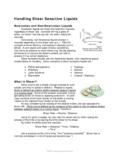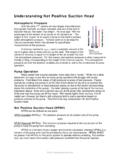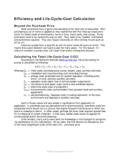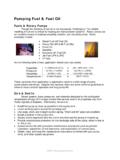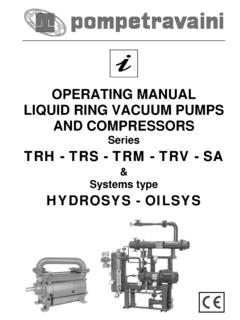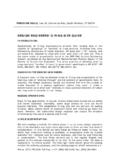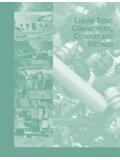Transcription of Liquid Containment - Pump School
1 Liquid Containment The Importance of Liquid Containment In light of the increasing emphasis on decreasing leakage of pollutants in the industrial setting, there is a need to become informed about sealing equipment under our control. Because pumps are generally considered to be more expensive than the piping, valves, and related accessories surrounding them, pumps are higher profile when they leak. Seal manufacturers are gearing up to meet the challenge but have thus far focused on centrifugal pump principles because tnumbers dominate the market. Positive-displa(PD) pumps may pose special sealing problems because they have been designed to handle viscous, non-Newtonian, or other problem fluids under a wide range of physical conditions. Many factors must be considered in order to arrive at the proper sealing solution.
2 Trifugal pump principles because tnumbers dominate the market. Positive-displa(PD) pumps may pose special sealing problems because they have been designed to handle viscous, non-Newtonian, or other problem fluids under a wide range of physical conditions. Many factors must be considered in order to arrive at the proper sealing solution. heir cement heir cement Types of Shaft Seals Types of Shaft Seals SEALLESS (MAG DRIVE) MECHANICAL SEALS LIP SEALS PACKING 2007 Packing Packing usually consists of braided or formed rings that are compressed in the stuffing box of the pump. As the packing is tightened, it compresses against the shaft and outer stuffing box bore to create the seal. Packing is one of the oldest forms of shaft sealing and used to be made from leather, rope, and flax.
3 Modern packing can be commonly found in inert materials such as expanded PTFE, compressed graphite, and granulated elastomers. Packed pumps are typically the most economical and are common for thick, difficult to seal liquids such as chocolate, molasses, asphalt, resins, tar, and some adhesives. Packing seldom catastrophically fails, allowing for replacement at scheduled shut down dates. Packing does have several drawbacks however. First of all, packing is a poor seal for thin liquids, especially at higher pressures. Secondly, packing requires lubrication either externally or by the Liquid being pumped. As a result, packing must to allowed to leak slightly (weep). This can be messy and in the case of corrosive, flammable, or toxic liquids is unacceptable. Lastly, abrasive particulate has a tendency to embed in packing which can damage the pump shaft.
4 Packing should not be used for handling abrasive liquids without use of a hardened or coated shaft. Lip Seals Lip Seals typically consist of a circular elastomeric seal element in a steel outer housing. The lip is often reinforced by a spring to help compress it to the shaft. Lip Seals are common throughout the hydraulic industry and can be found on pumps, hydraulic motors, and actuators. They are typically limited to low pressures and as such, pumps that use them have to be unidirectional so that the seal can be vented to the low pressure inlet side. They are also poor for thin, nlubricating liquids and abrasives, further limiting their usagRon-e. ecently, multiple lipseals mounted in a gland on a sleeveI / 10 d r Mechanical Seals ical seals alone could run on for volumes. In brief, typical mechally This have been applied successfully against a variety of viscous, nonabrasive liquids (figure 1).
5 Lip design and reinforcement allow operating at pressures to 150 PSBAR without supporting fluid pressure behind the lips. Glanports provide access to interior passages for cooling the lips oto pressurize internally. Figure 1 A Cross-Sectional View of a Triple Lip Cartridge Seal The topic of mechannical seals consist of highly polished faces (one stationary and one rotating) running against each other to form a seal. These seal faces are extremely flat, usuawithin about 33 millionths of an inch. They are virtually leak-free and handle a wide range of liquids, viscosities, pressures, and temperatures. The faces are often lubricated by the Liquid being pumped, but can be lubricated by external Liquid provides a thin, hydrodynamic film between the opposing seal faces. Mechanical seals come in a wide range of materials and types, including: 2007 Single Component Seals - Single seals are classified as pusher or nonpusher types n example of a single nonpusher mechanical seal.
6 Nonpusher seals are characterized by a s mechae shaft er ear, asket is also an example of a positive drivby setsating e n l, but utilizesis, combined with hardened f a re betweenric or with single-spring or multiple-spring sub-classifications. They can be friction driven or positively driven. Figure 2 is aFigure 2 A Nonpusher Belloshaft gasket or bellows that remains stationary with respectto the shaft. A tightly fitted rubber bellows is spring loaded against a soft face. All components are enclosed within a metal retainer and turn with the shaft against a stationary face. As the rotating face wears, the flexible rubber bellowextends to maintain sealing contact with the stationary face. Figure 3 is an example of a single pusher ws Seal nical seal. Whereas in a nonpusher seal thgasket does not move in relationship to the shaft, in a pushseal, the shaft gasket must move.
7 As the seal faces wmechanical and hydraulic forces push the shaft gasket forward to maintain contact with the faces. Pusher type seals can begin to leak when normal product leakage combined with face wear builds up to cause the shaft gto "hang up". Figure 3 e seal, which are locked to the shaft crews. They utilize O-ring, Vee-ring, or similar configuration to seal along the shaft and against the rotface. The stationary face is usually fitted with an anti-rotation device, depending upon face configuration andmaterial of secondary seal. Mechanical links between thseal and the shaft, and among components of the rotating portion, put the seal in the positive drive classification. Frictionally driven seals like figure 2 can only be used inviscosities to 3,300 cSt (15,000 SSU). Setscrew drive cabe used in viscosities to 5,500 cSt (25,000 SSU).
8 Figure 4 is another positive drive, pusher seaFigure 3 A Positive Drive, Pusher Seal Figure 4 A Positive Drive, Pusher Seal for Thick and/or Abrasive Liquids a pin in the shaft to provide the driving means. Thseal faces makes this seal ideal for viscous liquids to over 16,500 cSt (75,000 SSU). It s also widely used for abrasive liquids as well such as paints, inks, and waste oils. Double Seals - As the name implies, double seals utilize two sets of sealing elements. The seals in Figure 5 are identical tothe seal in Figure 3, but are positioned back to back. The space internal to the two sets of seal faces must be hydraulically pressurized in order to close both sets ofaces. For best results, the pressurized Liquid must be lubricant and compatible with the product. Internal pressunormally maintained at 10 to 15 PSI (.)
9 7 to BAR) higher than adjacent atmospheproduct side pressure. Thus, the film on the seal faces necessary for lubrication will be Figure 5 A Double, Pusher Seal the seals is 2007 the barrier Liquid , not the Liquid being pumped. This arrangement can be used to seal noxious liquids, hazardous liquids, or those too viscous for a single seal to handle; because all the seal components are rotating in a "friendly" environment. The barrieliquid protects the seal faces while excluding product and atmosphere. Friction drive double seals have been successful in 33,000 cSt (150,000 SSU) viscosity Liquid , and setscrew drive double seals can be applied to 55,000 cSt (250,000 SSU). Pressure ongood lubricating barrier Liquid between the seals can be up to 250 PSI (17 BAR). Like double seals, tandem seals utilize r a ants, but , contaminate the barrier lubricant land ndle as either true rrier d me nd artridge seal at higher f the chnology in mechanical face seals, starts to tops.
10 Some to escape to atmosphere. Tandem Seals - two seals, but are oriented in the same direction hydraulically rather than back to back. Both arrangements require the use of barrier/lubriconly the double must be pressurized. For tandem sealsonly the product side seal rotates in the product, but product weepage across the seal faces will eventually(Figure 6). The consequences of this contamination upon the atmospheric side seal or the surrounding environment depend upon the nature of the product. Cartridge seals are complete single, Figure 6 A Tandem SealCartridge Seals - double, or tandem mechanical seals contained within a gand built onto a sleeve (figure 7). Single cartridge seals will operate within roughly the same physical parameters as component positive-drive mechanical seals. They can haviscosities to 7,700 cSt (35,000 SSU), pressures to 300 PSI (20 BAR), and temperatures to 400 F (205 C).
